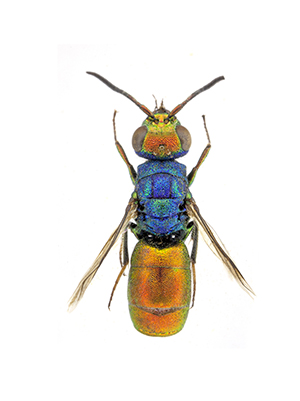Last updated on November 28th, 2023
 From: Kimsey L.S. & Bohart R.M., 1990 (1991) – The chrysidid wasps of the world. Oxford University Press, ix-652 pp.
From: Kimsey L.S. & Bohart R.M., 1990 (1991) – The chrysidid wasps of the world. Oxford University Press, ix-652 pp.
Synonymy
Chrysura Dahlbom, 1845: 6. Typus: austriaca Fabricius, 1804: 173
Monochrysis Lichtenstein, 1876: 27. Typus: Chrysis hybrida Lepeletier, 1806: 128
Olochrysis Lichtenstein, 1876: 27. Typus: Chrysis aerata Dahlbom, 1854: 129 (= Chrysis trimaculata Foerster, 1853)
Holochrysis Rye, 1878: 134. Invalid emendation.
Conochrysis Haupt, 1956: 37. Typus: Chrysis refulgens Spinola, 1806: 8
Arctochrysis Haupt, 1956: 72. Typus: Chrysis austriaca Fabricius, 1804: 173
Taeniochrysis Haupt, 1956: 72. Typus: Chrysis dichroa Dahlbom, 1854: 146
Selenochrysis Haupt, 1956: 72. Typus: Chrysis candens Germar, 1817: 260
Generic diagnosis
Face relatively flat without medial zone of cross ridging but sometimes with medial microreticulation; no TFC; malar space usually 2 MOD or more; mandible with subapical tooth; mid ocellus not lidded; basal flagellomeres F-II-V of male often bulging ventrally; pronotum not longer and usually shorter than scutellum, lateral depression shallow and barely indicated; mesopleuron with scrobal sulcus and episternal sulcus; propodeal angle subtriangular; fore wing discoidal cell complete; T-II longitudinal ridge sometimes indicated but not sharp; T-III pit row not deeply sunken and often quite weak, apical rim evenly rounded, truncate or indented medially. Male terminalia: S-VII1 subtriangular; gonocoxa broad or narrowly tapering apically, inner margin often angulate subapically; cuspis long, digitus slender and shorter than cuspis; aedeagus slender and acute apically.
Host
All known hosts are bees of the family Megachilidae (Hicks 1934). Most records are of the widespread and essentially Holarctic genus Osmia (Linsenmaier 1959a, Krombein 1967), which ordinarily nest in decaying logs or in the ground. Horning and Bohart (in Bohart and Kimsey) (1982) recorded additional twig-nesting host genera for sagmatis, a relatively abundant species in western North America. These were Ashmeadiella, Chelostoma, Hoplitis, Antkocopa, and Proteriades.
Discussion
Chrysura is the second largest genus in the Chrysidini. An important diagnostic feature is the relatively flat face without transverse microridging, but sometimes with a little medial microreticulation. In addition, there is no TFC, no teeth on T-III, and the lateral hollow on the pronotum is weak or only slightly indicated. We have divided the genus into five species groups, in four of which (radians, dichroa, cuprea, candens) male F-II-V (especially F-II-IV) are asymmetrical (knobby) beneath. Linsenmaier (1959a) included Chrysura in Chrysis and separated the first three groups from the austriaca group on the base of the male antennae. Since the ‘knobby’ antennal character crops up in several Chrysis groups, as well as Spintharina and Ceratochrysis, we do not place as much weight on it as did Linsenmaier. Furthermore, as an intergrade we have a male cirtana (determined by Mocsáry) in which F-II-V are slightly asymmetrical. This species, along with candens, was put in the austriaca group by Linsenmaier, but we place them in a separate candens group. The 10 Nearctic species of Chrysura are all in the radians group. Although they do not have the red abdomen found in many of the Palearctic species, and the metanotum is not produced, we do not think this is justification for a separate group. A key to these species was given by Horning and Bohart (in Bohart and Kimsey 1982). The name of the largest group of Chrysura was informally proposed as pustulosa by Linsenmaier (1959a). Since pustulosa Abeille (1878) has been synonymized under radians Harris (1776) by Morgan (1984), we are now using radians as the name for the group Altogether, we have been able to study authenticated specimens (mainly types) of about 80 percent of the species we have listed. However, our studies were made at different times and places, so that direct comparisons were not possible. Therefore, there may well be some undetected synonymy in the species studied and there is likely to be some additional synonymy among those which we have not been able to see.
European species
- Chrysura arcadiae (Arens, 2001)
- Chrysura auropicta (Mocsáry, 1889)
- Chrysura austriaca (Fabricius, 1804)
- Chrysura baccha (Balthasar, 1953)
- Chrysura candens (Germar, 1817)
- Chrysura ciliciensis (Mocsáry, 1914)
- Chrysura circe (Mocsáry, 1889)
- Chrysura cretica (Mocsáry, 1911)
- Chrysura cuprea (Rossi, 1790)
- Chrysura declinanalis (Linsenmaier, 1968)
- Chrysura demaculata (Arens, 2004)
- Chrysura dichroa (Dahlbom, 1854)
- Chrysura dichroa rhodosiana (Linsenmaier, 1959)
- Chrysura dichroa socia (Dahlbom, 1854)
- Chrysura dichropsis (Buysson, 1891)
- Chrysura erigone (Mocsáry, 1889)
- Chrysura fernandezi (Linsenmaier, 1993)
- Chrysura filiformis (Mocsáry, 1889)
- Chrysura foveatidorsa (Linsenmaier, 1968)
- Chrysura graja (Mocsáry, 1889)
- Chrysura hirsuta (Gerstaecker, 1869)
- Chrysura hybrida (Lepeletier, 1806)
- Chrysura hybrida sardiniensis (Linsenmaier, 1959)
- Chrysura ignifrons Brullé, 1833
- Chrysura isabella (Trautmann, 1926)
- Chrysura judith (Balthasar, 1953)
- Chrysura krueperi Mocsáry, 1889
- Chrysura laconiae (Arens, 2001)
- Chrysura laevigata (Abeille, 1879)
- Chrysura laevigata fortiterpunctata (Linsenmaier, 1959)
- Chrysura laodamia (Buysson, 1900)
- Chrysura laodamia iphimedeia (Trautmann, 1926)
- Chrysura lydiae (Mocsáry, 1889)
- Chrysura lydiae allegata (Linsenmaier, 1968)
- Chrysura magrettii (Buysson, 1890)
- Chrysura mesochlora (Mocsáry, 1892)
- Chrysura mistrasensis (Linsenmaier, 1968)
- Chrysura moreae (Arens, 2001)
- Chrysura oraniensis (Lucas, 1849)
- Chrysura oraniensis porphyrea (Mocsáry, 1889)
- Chrysura pelopaeicida (Buysson, 1887)
- Chrysura pseudodichroa (Linsenmaier, 1959)
- Chrysura purpureifrons (Abeille, 1878)
- Chrysura purpureifrons helleniensis (Linsenmaier, 1968)
- Chrysura pyrogaster (Brullé, 1833)
- Chrysura radians (Harris, 1776)
- Chrysura refulgens (Spinola, 1806)
- Chrysura rhodia (Mocsáry, 1889)
- Chrysura rufiventris (Dahlbom, 1854)
- Chrysura rufiventris rudis (Buysson, 1891)
- Chrysura simplex (Dahlbom, 1854)
- Chrysura simplex ampliata (Linsenmaier, 1968)
- Chrysura simulacra Linsenmaier, 1959
- Chrysura simuldichroa (Linsenmaier, 1969)
- Chrysura smaragdina (Trautmann, 1926)
- Chrysura smyrnensis (Mocsáry, 1889)
- Chrysura sulcata (Dahlbom, 1845)
- Chrysura sulcata schlaeflei Linsenmaier, 1997
- Chrysura trimaculata (Förster, 1853)
- Chrysura varicornis Spinola, 1838
- Chrysura viridana (Dahlbom, 1854)
Copyright, Authorship, and Ownership statements
All text and images of this page are copyright ©️ Chrysis.net unless otherwise stated - please see individual cases for authorship and copyright details. The specimens pictured are from the authors' or other collaborators' personal collections and from the collections of various museums. Unless otherwise specified, the whole content of this web site is for personal, non-commercial, scientific, and educational purposes given proper accreditation to the page from which they were derived are provided, and under Chrysis.net Terms and Conditions.
For citation purposes
Agnoli G.L. & Rosa P. (2025) Genus Chrysura Dahlbom, 1845, in: Chrysis.net website. Interim version 03 July 2025, URL: https://www.chrysis.net/database/genus-chrysura/.




